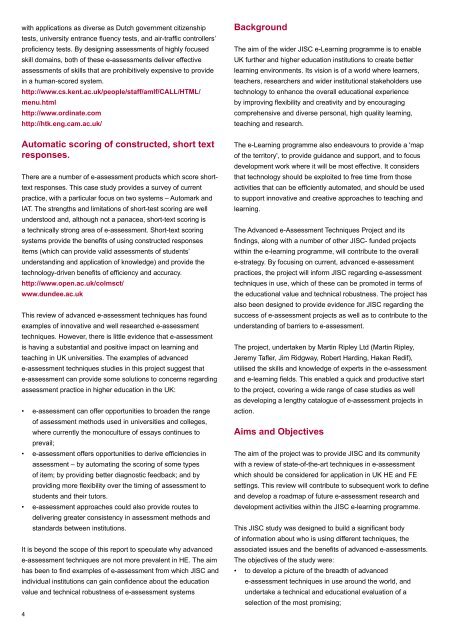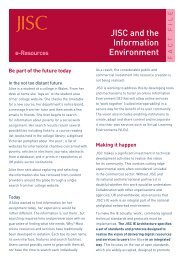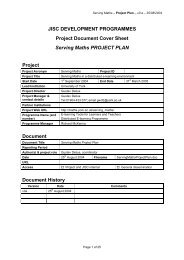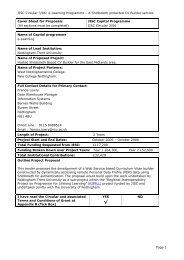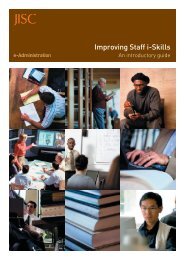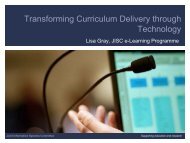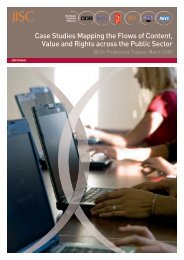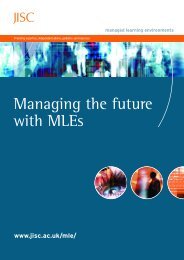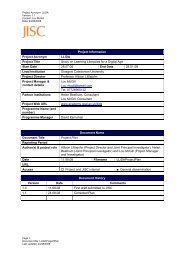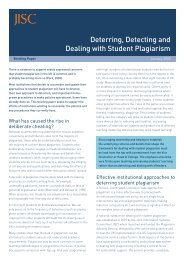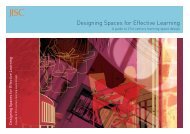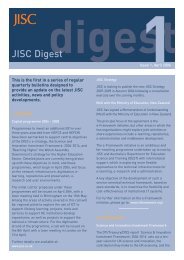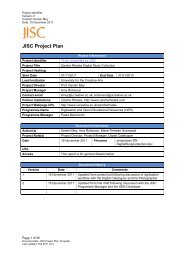Review of Advanced e-Assessment Techniques (RAeAT) Final ... - Jisc
Review of Advanced e-Assessment Techniques (RAeAT) Final ... - Jisc
Review of Advanced e-Assessment Techniques (RAeAT) Final ... - Jisc
You also want an ePaper? Increase the reach of your titles
YUMPU automatically turns print PDFs into web optimized ePapers that Google loves.
with applications as diverse as Dutch government citizenship<br />
tests, university entrance fluency tests, and air-traffic controllers’<br />
pr<strong>of</strong>iciency tests. By designing assessments <strong>of</strong> highly focused<br />
skill domains, both <strong>of</strong> these e-assessments deliver effective<br />
assessments <strong>of</strong> skills that are prohibitively expensive to provide<br />
in a human-scored system.<br />
http://www.cs.kent.ac.uk/people/staff/amlf/CALL/HTML/<br />
menu.html<br />
http://www.ordinate.com<br />
http://htk.eng.cam.ac.uk/<br />
Automatic scoring <strong>of</strong> constructed, short text<br />
responses.<br />
There are a number <strong>of</strong> e-assessment products which score shorttext<br />
responses. This case study provides a survey <strong>of</strong> current<br />
practice, with a particular focus on two systems – Automark and<br />
IAT. The strengths and limitations <strong>of</strong> short-test scoring are well<br />
understood and, although not a panacea, short-text scoring is<br />
a technically strong area <strong>of</strong> e-assessment. Short-text scoring<br />
systems provide the benefits <strong>of</strong> using constructed responses<br />
items (which can provide valid assessments <strong>of</strong> students’<br />
understanding and application <strong>of</strong> knowledge) and provide the<br />
technology-driven benefits <strong>of</strong> efficiency and accuracy.<br />
http://www.open.ac.uk/colmsct/<br />
www.dundee.ac.uk<br />
This review <strong>of</strong> advanced e-assessment techniques has found<br />
examples <strong>of</strong> innovative and well researched e-assessment<br />
techniques. However, there is little evidence that e-assessment<br />
is having a substantial and positive impact on learning and<br />
teaching in UK universities. The examples <strong>of</strong> advanced<br />
e-assessment techniques studies in this project suggest that<br />
e-assessment can provide some solutions to concerns regarding<br />
assessment practice in higher education in the UK:<br />
••<br />
e-assessment can <strong>of</strong>fer opportunities to broaden the range<br />
<strong>of</strong> assessment methods used in universities and colleges,<br />
where currently the monoculture <strong>of</strong> essays continues to<br />
prevail;<br />
••<br />
e-assessment <strong>of</strong>fers opportunities to derive efficiencies in<br />
assessment – by automating the scoring <strong>of</strong> some types<br />
<strong>of</strong> item; by providing better diagnostic feedback; and by<br />
providing more flexibility over the timing <strong>of</strong> assessment to<br />
students and their tutors.<br />
••<br />
e-assessment approaches could also provide routes to<br />
delivering greater consistency in assessment methods and<br />
standards between institutions.<br />
It is beyond the scope <strong>of</strong> this report to speculate why advanced<br />
e-assessment techniques are not more prevalent in HE. The aim<br />
has been to find examples <strong>of</strong> e-assessment from which JISC and<br />
individual institutions can gain confidence about the education<br />
value and technical robustness <strong>of</strong> e-assessment systems<br />
4<br />
Background<br />
The aim <strong>of</strong> the wider JISC e-Learning programme is to enable<br />
UK further and higher education institutions to create better<br />
learning environments. Its vision is <strong>of</strong> a world where learners,<br />
teachers, researchers and wider institutional stakeholders use<br />
technology to enhance the overall educational experience<br />
by improving flexibility and creativity and by encouraging<br />
comprehensive and diverse personal, high quality learning,<br />
teaching and research.<br />
The e-Learning programme also endeavours to provide a 'map<br />
<strong>of</strong> the territory', to provide guidance and support, and to focus<br />
development work where it will be most effective. It considers<br />
that technology should be exploited to free time from those<br />
activities that can be efficiently automated, and should be used<br />
to support innovative and creative approaches to teaching and<br />
learning.<br />
The <strong>Advanced</strong> e-<strong>Assessment</strong> <strong>Techniques</strong> Project and its<br />
findings, along with a number <strong>of</strong> other JISC- funded projects<br />
within the e-learning programme, will contribute to the overall<br />
e-strategy. By focusing on current, advanced e-assessment<br />
practices, the project will inform JISC regarding e-assessment<br />
techniques in use, which <strong>of</strong> these can be promoted in terms <strong>of</strong><br />
the educational value and technical robustness. The project has<br />
also been designed to provide evidence for JISC regarding the<br />
success <strong>of</strong> e-assessment projects as well as to contribute to the<br />
understanding <strong>of</strong> barriers to e-assessment.<br />
The project, undertaken by Martin Ripley Ltd (Martin Ripley,<br />
Jeremy Tafler, Jim Ridgway, Robert Harding, Hakan Redif),<br />
utilised the skills and knowledge <strong>of</strong> experts in the e-assessment<br />
and e-learning fields. This enabled a quick and productive start<br />
to the project, covering a wide range <strong>of</strong> case studies as well<br />
as developing a lengthy catalogue <strong>of</strong> e-assessment projects in<br />
action.<br />
Aims and Objectives<br />
The aim <strong>of</strong> the project was to provide JISC and its community<br />
with a review <strong>of</strong> state-<strong>of</strong>-the-art techniques in e-assessment<br />
which should be considered for application in UK HE and FE<br />
settings. This review will contribute to subsequent work to define<br />
and develop a roadmap <strong>of</strong> future e-assessment research and<br />
development activities within the JISC e-learning programme.<br />
This JISC study was designed to build a significant body<br />
<strong>of</strong> information about who is using different techniques, the<br />
associated issues and the benefits <strong>of</strong> advanced e-assessments.<br />
The objectives <strong>of</strong> the study were:<br />
••<br />
to develop a picture <strong>of</strong> the breadth <strong>of</strong> advanced<br />
e-assessment techniques in use around the world, and<br />
undertake a technical and educational evaluation <strong>of</strong> a<br />
selection <strong>of</strong> the most promising;<br />
••<br />
to present short case studies describing the technical,<br />
educational and operational details <strong>of</strong> a selection <strong>of</strong> the most<br />
significant examples;<br />
••<br />
to look at wider generic technologies and investigate how and<br />
when these might be applied to e-assessment;<br />
••<br />
to draw conclusions about how the most relevant <strong>of</strong><br />
these could be applied to UK FE and HE settings, and<br />
provide advice to JISC and its community about how such<br />
applications could be developed.<br />
The project has delivered the aims and objectives by:<br />
••<br />
identifying a range <strong>of</strong> advanced e-assessment techniques<br />
in use in HE and the wider environment that currently totals<br />
over 90 in number;<br />
••<br />
selecting and studying in depth seven projects covering the<br />
major areas <strong>of</strong> test and assessment systems: task/test design;<br />
administration; marking, scoring and making judgements.<br />
••<br />
obtaining information about:<br />
- the range <strong>of</strong> users <strong>of</strong> the selected techniques;<br />
- the educational and technological benefits;<br />
- the key issues.<br />
Agree<br />
Protocols<br />
Agree protocols<br />
and frameworks<br />
Develop and<br />
review protocols<br />
Pilot<br />
Conduct<br />
Fieldwork<br />
Preparation<br />
First phase<br />
<strong>of</strong> fieldwork<br />
Desk reviews,<br />
interviews<br />
and any visits<br />
The project aims and objectives have remained consistent<br />
throughout the duration <strong>of</strong> the project, and there were no major<br />
changes made either to those objectives or to the agreed<br />
approach that was taken to achieve the objectives. The following<br />
specific questions were identified by JISC for this project.<br />
••<br />
To what extent has the project and the related case studies<br />
contributed to increased knowledge <strong>of</strong> e-assessment?<br />
••<br />
What were the unanticipated outcomes?<br />
••<br />
To what extent have the project activities remained relevant<br />
to the strategic needs <strong>of</strong> the sector?<br />
••<br />
What does JISC need to do next as a result <strong>of</strong> conclusions<br />
emerging from the project?<br />
Responses are provided below in the Conclusions section.<br />
Methodology and Implementation<br />
Our methodological approach to this project was to adopt a case<br />
study design, applying this separately for the development <strong>of</strong><br />
the catalogue, the case studies and the technical review. Our<br />
approach, set out in the diagram below, is based on Yin’s case<br />
study methods 1 .<br />
Analysis &<br />
Findings<br />
Develop and<br />
review strategy<br />
Analysis<br />
Conclusions &<br />
Report Writing<br />
Findings<br />
workshop<br />
Outline main<br />
conclusions<br />
Report writing<br />
1<br />
Yin, R.K. (2003) Applications <strong>of</strong> Case Study Research, Second Edition, Applied Social Research Methods Series, Vol. 34, Sage Publications.<br />
ISBN 0 7619 2551 1 http://www.paperfree.co.uk/ Paperfree Systems Ltd – e-Portfolio system.<br />
5


